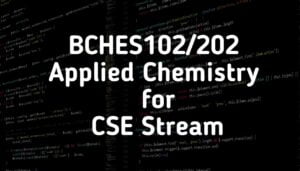
BCHES102/202 Applied Chemistry for CSE Stream
Syllabus Copy
Module - 1
SensorsandEnergySystems
Sensors:
Introduction,working,principleandapplicationsofConductometricsensors,Electrochemical sensors,Thermometricsensors (Flame photometry) and Opticalsensors (colorimetry).Sensorsforthemeasurement of dissolved oxygen (DO). Electrochemical sensors for the pharmaceuticals.ElectrochemicalgassensorsforSOxandNOx.Disposablesensorsin thedetectionofbiomoleculesandpesticides.
EnergySystems:
Introductiontobatteries,construction,workingandapplicationsofLithiumionandSo diumionbatteries.QuantumDotSensitizedSolarCells(QDSSC’s)-Principle, Propertiesand Applications.
Self-learning:
Types of electrochemical sensor, Gas sensor – O2 sensor, Biosensor – Glucosesensors
Module - 2
MaterialsforMemoryandDisplaySystems
Memory Devices:
Introduction, Basic concepts of electronic memory, History of organic/polymerelectronic memorydevices,Classification of electronic memory devices , types of organic memory devices(organicmolecules,polymericmaterials,organicinorganichybridmaterials).
DisplaySystems:
Photoactiveandelectroactivematerials,Nanomaterialsandorganicmaterials used in optoelectronic devices. Liquid crystals (LC’s) – Introduction, classification,properties and
application in Liquid Crystal Displays (LCD’s). Properties and application ofOrganic Light
Emitting Diodes (OLED’s) and Quantum Light Emitting Diodes (QLED’s),
Lightemittingelectrochemicalcells.
Self learning:
PropertiesandfunctionsofSilicon(Si),Germanium(Ge),Copper(Cu),
Aluminium(Al),andBrominatedflameretardantsincomputers.
Module - 3
CorrosionandElectrodeSystem
CorrosionChemistry:
Introduction,electrochemicaltheoryofcorrosion,typesofcorrosiondifferentialmetalanddifferentialaeration.Corrosioncontrol-galvanization,anodization and sacrificial anode method. Corrosion Penetration Rate (CPR) – Introductionandnumerical problem.
Electrode System:
Introduction, types of electrodes. Ion selective electrode – definition,construction, working and applications of glass electrode. Determination of pH using glasselectrode. Reference electrode- Introduction, calomel electrode– construction, working and applications of calomelelectrode. Concentrationcell–Definition,constructionandNumericalproblems.
Analytical Techniques:
Introduction, principle and instrumentation of Conductometry;
itsapplication in the estimation of weak acid. Potentiometry; its application in the
estimationofiron.
Self-learning:
IRandUV-Visiblespectroscopy.
Module - 4
PolymersandGreenFuels
Polymers:
Introduction,MolecularweightNumberaverage,weightaverageandnumericalproblems.Preparation,properties,andcommercialappl
icationsofkevlar. Conductingpolymers–
synthesisand conducting mechanism of polyacetyleneand commercia lapplications.
Green Fuels: Introduction, construction and working of solar photovoltaic cell, advantages,and
disadvantages. Generation of energy (green hydrogen) by electrolysis of water and itsadvantages.
Self-learning:Regenerativefuelcells
Module - 5
E-WasteManagement
E-Waste:
Introduction, sources of e-waste, Composition, Characteristics, and Need of ewastemanagement.Toxicmaterialsusedinmanufacturingelectronicandelectricalproducts, health hazards due to exposure to e-waste. Recycling and Recovery: Differentapproachesofrecycling(separation,thermaltreatments,hydrometallurgicalextraction,pyro metallurgical methods, direct recycling). Extraction of gold from E-waste. Role of stakeholders in environmental management of e-waste (producers, consumers, recyclers, andstatutorybodies).
Self-learning:
Impactofheavymetalsonenvironmentandhumanhealth.